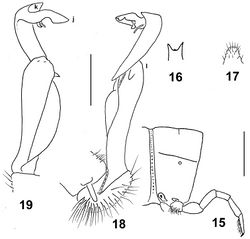Eustrongylosoma maculatum
| Notice: | This page is derived from the original publication listed below, whose author(s) should always be credited. Further contributors may edit and improve the content of this page and, consequently, need to be credited as well (see page history). Any assessment of factual correctness requires a careful review of the original article as well as of subsequent contributions.
If you are uncertain whether your planned contribution is correct or not, we suggest that you use the associated discussion page instead of editing the page directly. This page should be cited as follows (rationale):
Citation formats to copy and paste
BibTeX: @article{Golovatch2011InternationalJournalofMyriapodology5, RIS/ Endnote: TY - JOUR Wikipedia/ Citizendium: <ref name="Golovatch2011International Journal of Myriapodology5">{{Citation See also the citation download page at the journal. |
Ordo: Polydesmida
Familia: Paradoxosomatidae
Genus: Eustrongylosoma
Name
Eustrongylosoma maculatum Golovatch & Stoev, 2011 sp. n. – Wikispecies link – ZooBank link – Pensoft Profile
Type material
Holotype♂(NMNHS),Papua New Guinea, West Sepik Province, Telefomin area, September 1975, leg. B.S.E.
Name
To reflect the wide spots/bands in the front halves of the collum, following metaterga and epiproct.
Diagnosis
Distinguished by the very poorly developed paraterga, coupled with a non-fringed tip of the solenophore (see also Key below).
Description
Length ca 24 mm, width of pro- and metazona 2.0 and 2.4 mm, respectively. Coloration light yellow-brown with front halves of collum, following metaterga and epiproct, as well as entire head and antennae contrasting brown, thus creating a clear cingulate pattern.
In width, head > collum = segment 3 = 4 < 2 < 5–16; thereafter body gently tapering towards telson. Head densely setose, only vertex bare. Antennae rather short, clavate, reaching beyond segment 2 dorsally; antennomere 6 longer than 2nd. Collum transversely oval, lateral flaps small, regularly and broadly rounded. Tegument generally smooth and shining. Paraterga of postcollum segments very poorly developed (Fig. 15), set low (at about 1/2–1/3 midbody height); paratergum 2 a low ridge with a few wrinkles above; paraterga 3 and 4 virtually missing, traceable only as 3–4 similar wrinkles; following paraterga retained only as a dorsal sulcus/line (Fig. 15), barely visible in segment 19. Ozopores lateral, superficial. Tergal setae mostly abraded, retained ones about 1/4 the length of metaterga; setation pattern vague, sometimes traceable as 1+1 paramedian insertion points in front row. Axial line wanting. Transverse sulcus on metaterga highly superficial, incomplete, far from reaching bases of paraterga, visible only in metaterga 9–17. Stricture between pro- and metazona rather distinctly beaded. Pleurosternal carinae very small, complete crests or nearly so only in segments 2–4. Epiproct (Fig. 16) short, flattened dorsoventrally, digitiform; apical papillae very large, spiniform, directed more caudally than ventrally; subapical papillae missing. Hypoproct subtriangular, apex rounded, setigerous paramedian knobs at caudal margin small and rather faintly separated.
Sterna densely setose; a rather high, linguiform, caudally rounded, ventral, setose lamina only between ♂ coxae 4 (Fig. 17). Legs relatively long, midbody ones ca 1.5–1.6 times longer than body height, apparently slightly incrassate and longer compared to ♀; ♂evident tarsal brushes increasingly well reduced towards legs of segment 10.
Gonopods as in Figs 18 & 19. Distal part of solenophore split into a distinct frontomesal tooth (k) and a longer, somewhat curved lateral branch (j) with two subapical denticles and a lobule. Femorite with a large, rounded, apicolateral lobe (l).
Original Description
- Golovatch, S; Stoev, P; 2011: Review of the millipede genus Eustrongylosoma Silvestri, 1896 in the island of New Guinea, with descriptions of nine new species (Diplopoda, Polydesmida, Paradoxosomatidae) International Journal of Myriapodology, 5: 1-26. doi
Images
|
